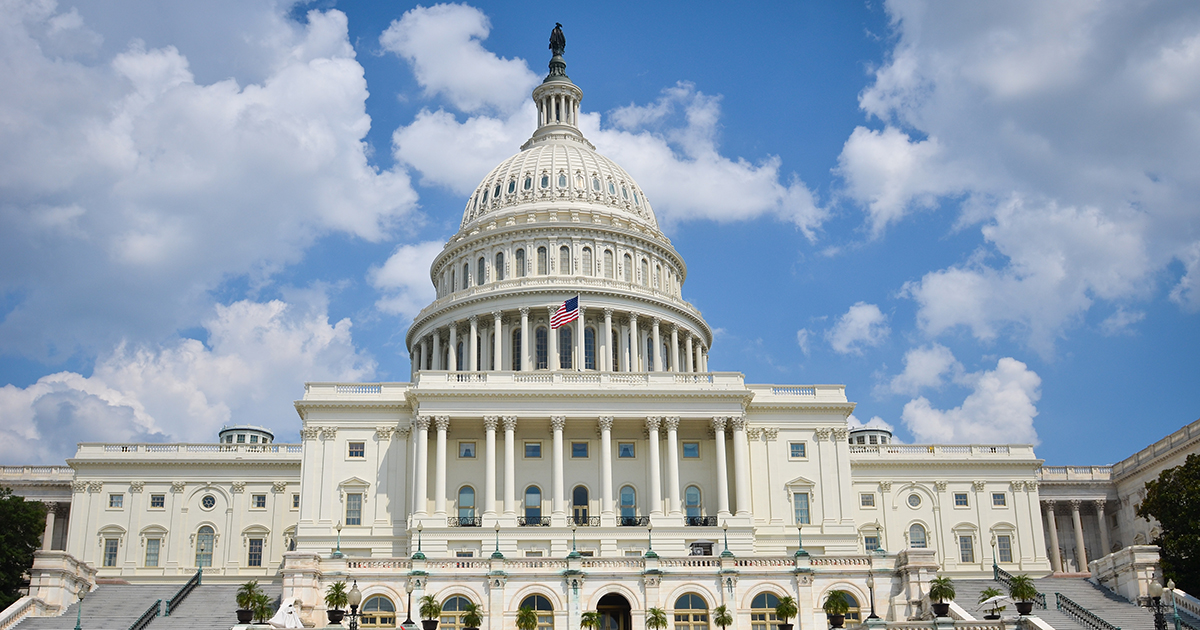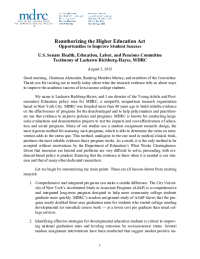Testimony on Opportunities to Improve Student Success in the Higher Education Act
Presented Before the U.S. Senate Committee on Health, Education, Labor, and Pensions

Good morning, Chairman Alexander, Ranking Member Murray, and members of the Committee. Thank you for inviting me to testify today about what the research evidence tells us about ways to improve the academic success of low-income college students.
My name is Lashawn Richburg-Hayes, and I am director of the Young Adults and Postsecondary Education policy area for MDRC, a nonprofit, nonpartisan research organization based in New York City. MDRC was founded more than 40 years ago to build reliable evidence on the effectiveness of programs for the disadvantaged and to help policymakers and practitioners use that evidence to improve policies and programs. MDRC is known for conducting large-scale evaluations and demonstration projects to test the impacts and cost-effectiveness of education and social programs. Many of our studies use a random assignment research design, the most rigorous method for assessing such programs, which is able to determine the value an intervention adds to the status quo. This method, analogous to the one used in medical clinical trials, produces the most reliable evidence that a program works. As a result, it is the only method to be accepted without reservations by the Department of Education’s What Works Clearinghouse. Given that resources are limited and problems are very difficult to solve, proceeding with evidenced-based policy is prudent. Ensuring that the evidence is there when it is needed is our mission and that of many other dedicated researchers.
Let me begin by summarizing my main points. These are all lessons drawn from existing research:
-
Comprehensive and integrated programs can make a sizable difference. The City University of New York’s Accelerated Study in Associate Programs (ASAP) is a comprehensive and integrated long-term program designed to help more community college students graduate more quickly. MDRC’s random assignment study of ASAP shows that the program nearly doubled three-year graduation rates for students who started college needing developmental (or remedial) course work — at a lower cost per graduate than usual college services.
-
Identifying effective strategies for developmental education students is critical to improving national graduation rates and leveling outcomes by socioeconomic status. Several random assignment interventions have been conducted that suggest modest positive improvements in outcomes are possible. Second-generation interventions are currently being evaluated and findings will be available shortly to inform policymakers and practitioners about what works in this area.
-
ASAP is one example of a program that implemented elements of a structured pathway approach, which is based on the idea that simple, well-defined programs of study may help more students complete community college. Most community college students are offered a vast array of courses and options to arrange their schedules and earn credentials. In theory, these allow them to match their interests with the right program. In reality, however, they leave many students confused and overwhelmed.
-
Financial aid is an important lever to help low-income students succeed. Given both the size of the financial aid system ($226 billion) and the widespread use of financial aid for various purposes, financial aid must be thought of as another tool that can be used to improve academic success and postsecondary completion. A growing body of work has studied interventions that use financial aid as an incentive to improve academic success. Nine such studies demonstrate that incentive-based grants — an innovation on traditional financial aid — result in a larger proportion of students meeting academic benchmarks, a greater number of credits earned, and modest effects on grade point average in the first year. Work by MDRC in this area has shown that incentive-based grants can increase first-year enrollment when the intervention targets graduating high school seniors.
Recommendations
-
Give colleges and states incentives to replicate proven programs. For example, the federal government could support the spread of ASAP. This could be through funding mechanisms such as First in the World. This year’s First in the World competition did encourage applicants to propose replicating interventions that had strong evidence, but additional support could be fostered through future competitions and also through other funding mechanisms.
- Encourage innovation paired with research, especially rigorous evaluation. Specifically, additional research could be conducted into structured pathways, year-round financial aid, and work-study programs.
- The Department of Education (or other parts of the federal government) can encourage tests of structured pathways. Components of structured pathways have been studied in different fields but evidence is lacking on the effectiveness of an entire model. A center focused on structured pathways or a grant competition with long-term support can foster more research in this area.
-
The Department of Education can test Pell Grant funding to cover the summer term of the academic year. Offering Pell Grant aid to students during the summer would offer an opportunity to test whether aid during short terms (that is, those less than 12 weeks in duration) helps students make stronger progress toward degree completion. Tying the reintroduction of summer Pell awards to some of the other strategies discussed in this testimony (for example, incremental aid disbursements) could help control program costs and make the program more sustainable.
-
States and institutions could be encouraged to use internal or external grant funding to test whether summer funding improves outcomes. States and institutions with flexible grant aid dollars could allocate some of those funds to grants for summer or winter college enrollment, or both. Additionally, states and institutions could seek out partnerships with local and national donor organizations committed to helping low-income students graduate from college.
- The federal government could encourage a test that compares the current work-study model with a modified version designed to help low-income students make career advances while in college. Given the amount of money expended on this aid program ($972 million in academic year 2011-2012), it would be a worthy endeavor to clarify how that aid can help students most effectively.






